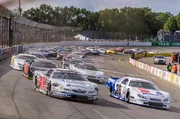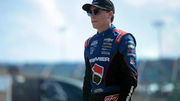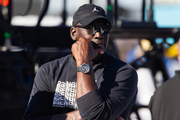
Imago
US PRESSWIRE Sports Archive Feb 17, 1985 Daytona Bch, FL, USA FILE PHOTO NASCAR, Motorsport, USA Winston Cup driver Richard Petty during the Daytona 500 at the Daytona International Speedway. Daytona Beach Florida UNITED STATES, EDITORIAL USE ONLY PUBLICATIONxINxGERxSUIxAUTxONLY Copyright: xMannyxRubio-USAxTODAYxSportsx 3936073

Imago
US PRESSWIRE Sports Archive Feb 17, 1985 Daytona Bch, FL, USA FILE PHOTO NASCAR, Motorsport, USA Winston Cup driver Richard Petty during the Daytona 500 at the Daytona International Speedway. Daytona Beach Florida UNITED STATES, EDITORIAL USE ONLY PUBLICATIONxINxGERxSUIxAUTxONLY Copyright: xMannyxRubio-USAxTODAYxSportsx 3936073
Modern-day NASCAR doesn’t look much like the one your granddad grew up watching. The sport has evolved at lightning speed. Cars have gone from the old-school stock bodies to the sleek, high-tech Next Gen machines that put more focus on parity and durability. The calendar isn’t just about ovals anymore either; you’ve got street courses and road races sprinkled in, shaking up the traditional playbook.
Watch What’s Trending Now!
And then there’s the playoff system, a format designed for drama, where one race can flip a driver’s entire season upside down. It’s fast, flashy, and more unpredictable than ever. But for all the new-age innovation and forward thinking, there are still jaw-dropping reminders from NASCAR’s past that stop you in your tracks. And one of those stories just came straight from “The King” himself.
ADVERTISEMENT
Richard Petty’s hidden health struggles
Richard Petty, known as “The King,” boasts one of the most illustrious careers in NASCAR history. Over 35 years, Petty amassed a staggering 200 Cup Series victories. This is a record that’s still unbroken. Plus, his illustrious career includes seven NASCAR championships and seven Daytona 500 wins, the most in the sport’s history.
His dominance spanned dirt tracks, superspeedways, and road courses, underscoring his adaptability and competitive drive. Petty’s legacy extends beyond the stats, as he became an icon shaping NASCAR’s identity and popularity. Yet, behind the legendary successes were health challenges quietly endured during races.
In an era when safety and medical protocols were less advanced, Petty suffered repeated bouts of carbon monoxide poisoning from toxic fumes seeping into his race car’s cockpit. “It was the carbon monoxide that ended my driving career as much as anything,” Petty recalled recently.
ADVERTISEMENT
Jeff Gluck talked about it on The Teardown podcast. “He would get like carbon monoxide poisoning during a race and he would get out, get oxygen, and then get back in the car.” This ailment was so severe that it led to the use of relief drivers. “And so like you had it was you know the whole relief driver thing is,” Gluck further added.
And yes, a relief driver means exactly what it says. A relief driver is an additional driver who takes over from the main driver during a race, typically due to the main driver’s fatigue, illness, or injury. Petty, himself, described the relief driver practice as a necessary but little-discussed aspect of racing. “Whole relief driver thing is something fans don’t realize. Back then, it was common when you felt you couldn’t finish or it got dangerous.”
ADVERTISEMENT
This hidden health battle shaped Petty’s racing approach and longevity. Despite medical struggles on-track, his fierce determination secured his place as a NASCAR legend. His experiences also underscored the evolution of driver safety standards over the decades. At the same time, it highlights the sacrifices endured by pioneers of the sport. Today, Petty’s story reveals the human side behind the glorified victories and immortalizes the resilience that defined his unparalleled NASCAR legacy.
Top Stories
NASCAR Champ’s Desperate Plea Got Rejected as Snowball Derby Official’s Bizarre Confession Sparks Outrage

Carson Hocevar Shuts Down NASCAR Star’s Embarrassing Snowball Derby Tantrum in Blunt Social Media Takedown

NASCAR Hits Back at Michael Jordan & Co.’s Key Witness After Shocking ‘Bankruptcy’ Claims

‘NASCAR on Sale’: Team Owners Interested to Buy Out France Family With $5B Price Tag

Federal Judge Puts NASCAR & Michael Jordan on Notice as Courtroom Frustration Mounts

How NASCAR’s safety has transformed since Petty’s era
The safety landscape in NASCAR has dramatically evolved since Richard Petty’s racing days. It reflects lessons learned from both tragedy and innovation. In the 1990s and early 2000s, driver fatalities and severe injuries spurred NASCAR to adopt a rigorous approach to safety technology and regulations.
ADVERTISEMENT
The most groundbreaking advancement came after Dale Earnhardt’s fatal crash at the 2001 Daytona 500. This incident accelerated the sport’s commitment to driver protection through mandatory head and neck restraint devices (HANS), improved seat belts, and full-face helmets.
NASCAR introduced the SAFER barriers (steel and foam walls designed to absorb impact energy), significantly reducing injuries in crashes where drivers hit the walls. Seating evolved to carbon-fiber construction with better positioning to protect drivers against intrusion and blunt force impacts. Restraint harnesses moved from the old five-point systems to six and later seven-point configurations. This helped securely restrain drivers during violent collisions.
Technology integration also improved crash data recording via black boxes. They have enabled engineering teams to analyze accidents quickly and develop new safety protocols. Track modifications and car design innovations, including roof flaps and aerodynamic aids, aim to prevent cars from going airborne during spins.
ADVERTISEMENT
Importantly, NASCAR’s shift from relying on driver discretion to mandated safety standards ensures uniform protection for all competitors. Early resistance, like drivers initially refusing the HANS device, has faded as the evidence for its life-saving benefits became undeniable.
Today, while racing remains inherently dangerous, the sport’s proactive embrace of scientific research, engineering, and strict safety mandates has saved countless lives. This is, undoubtedly, a transformation from the era when drivers like Petty endured severe conditions without modern protections. NASCAR now leads motorsport safety innovation, making the danger more manageable for today’s competitors.
ADVERTISEMENT
ADVERTISEMENT
ADVERTISEMENT

